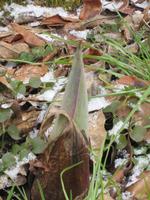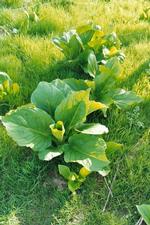Posted on Monday, January 16, 2012
Any careful observer walking the Lucile Frey Nature Trail this winter might be impressed with our earliest "spring flowering plant" now making its appearance in the wetlands. It is the somewhat-foul-smelling skunk cabbage, Symplocarpus foetidus, a member of the Arum family that also includes the Jack-in-the-Pulpit.
At least a half dozen other titles have been applied to Symplocarpus foetidus, whose name means what it says - a fetid odor. Among the common names are polecat weed and clumpfoot cabbage. A cabbage of the veggie garden it is not. But there are interesting parts to the life and times of our lowly swamp plant.
It is a true flower-producing plant. The flower, however, is not easily spotted. What is visible right now growing in wetlands is a spathe, a highly modified leaf or bud that forms a hood, often purple in color. Beautiful, actually! The spathe wraps around itself to form a space that encloses a spherical head of flowers (plural), called a spadix. If the temperatures of this winter continue, a month from now the flowers will be in full bloom, still enwrapped by the spathe. To see the head of flowers, get down on your knees and peek inside the narrow opening of the spathe. The flower head (about an inch in diameter) has a spongy consistency. There are numerous small, tightly packed individual flowers. They have no petals, the showy part of most flowers, but they have four inconspicuous, fleshy, straw-colored sepals that never really unfold.
On a warm day, which this winter may be in February and March, honey bees and other insects visit the spathe and the flowers inside to collect nectar and pollen to help the plant reproduce. If the day is not especially warm and the ground still has snow, look for a slightly melted area around the spathes. Melted? Yes. The skunk cabbage spathe is thermogenic, meaning it generates heat many degrees above air temperature. Writing in the journal Science in 1974, a botanist by the name of Knutson reported on this unusual detail of skunk cabbage. He concluded that the rate of metabolism, hence oxygen consumption, of a skunk cabbage is roughly equal to that of a shrew or a hummingbird, two animals known for their high energy level. Why heat? What this heat accomplishes is volatilizing the smelly compounds that mimic decomposing flesh and attract more pollinating insects. This is "win-win" for the skunk cabbage and the insects that escape a frigid life outside and find their mate in the cozy warmth of the spathe.
By March and April the heart-shaped leaves are evident. They appear wrapped like scrolls and grow rapidly to become the "cabbage" of the wetlands, two to three feet tall. In summer there is little odor associated with these leaves and black bears are known to feed on them.
There are still more interesting facts about skunk cabbage. In the 19th century, the U.S. Pharmacopoeia listed the skunk cabbage as a drug useful for treating respiratory diseases, nervous disorders, rheumatism and dropsy. Native Americans used skunk cabbage as a medicinal plant and seasoning for food preparation.
The "Native Plant Database" gives this recipe: Collect the bright green, unfurled leaves; soak in warm water to remove dirt and debris. Do not use dish detergent or any type of sanitizer. Carefully handle leaves after collecting because bruised leaves will give off an unpleasant smell (the smell disappears after cooking). Cook for 20 minutes, change the water at least twice and replace with fresh, boiling salted water. Serve like greens. Roots are very bitter and burning in their raw state. Peel, cut into small pieces, roast in an oven for at least one hour and grind in a coffee grinder until fine. Add to bread dough or muffin batter. This warning: All parts except uncurled leaves and roots are toxic if eaten in large quantities; skunk cabbage contains calcium oxalate crystals, which cause the most unpleasant burning sensation of the mouth and tongue.
If you travel to Tennessee, the skunk cabbage is a protected species and is regarded as endangered. Don't even think of picking it!
Clarence Harms, Director
Field Station
(724) 946-6001
harmsc@westminster.edu


